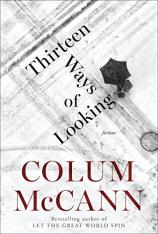Thirteen Ways of Looking: Fiction
Review
Thirteen Ways of Looking: Fiction
Wallace Stevens’ 1917 modernist poem, “Thirteen Ways of Looking at a Blackbird,” is among the writer’s most haunting works. It’s also one of his most inspiring. Many musicians have written pieces based on the poem’s 13 short stanzas. And eighth blackbird, the brilliant American music ensemble, takes its name from the poem’s eighth stanza, which begins “I know noble accents/And lucid, inescapable rhythms.” The stanzas evoke the cool mystery of winter, and the images of blackbirds amidst snowy mountains and bare trees and icicles that “filled the long window/With barbaric glass” are beautiful and portentous.
Beautiful and portentous are good words to describe THIRTEEN WAYS OF LOOKING, Colum McCann’s new collection of short fiction. The title novella and three stories that constitute this book demonstrate yet again McCann’s ability to inhabit a range of characters and bring disparate worlds to life, as he did in his two most recent works, LET THE GREAT WORLD SPIN and TRANSATLANTIC. The theme that connects these stories is the vagaries of chance, a theme that undoubtedly had special resonance for McCann. He was assaulted outside a Connecticut hotel last year when he tried to help a woman involved in a domestic dispute. That’s the sort of incident that would obsess anyone, let alone a writer justly celebrated for his poetic investigations into modern life’s greatest tragedies --- the September 11th attacks, the troubles in northern Ireland --- and the realization that, in any life, grief is never far away.
"The title novella and three stories that constitute this book demonstrate yet again McCann’s ability to inhabit a range of characters and bring disparate worlds to life..."
The title piece bears the closest resemblance to the incident in Connecticut. In 13 chapters, each preceded by a verse from the Stevens poem, McCann tells the story of Peter Mendelssohn, an 82-year-old former New York Supreme Court justice, on the day of his death. Mendelssohn, a widower whose Irish wife, Eileen, would buy him a volume of poetry whenever he won a case during his days as a district attorney, spends most of his days at home attached to an oxygen mask. A Tobago woman named Sally cares for him. One snowy December day, he tells her that he wants to go to an Italian restaurant for lunch with his son, Elliot, a go-getter hedge fund manager who is cheating on his “pile-up of peroxide” wife. At the end of the meal, as Peter waits outside in the cold, his face covered by a scarf, a man he doesn’t recognize pushes him to the ground. Peter hits his head on the pavement and dies.
The story is a McCann version of a thriller, in which the identity and fate of the murderer is withheld until the end. What distinguishes it from most thrillers is not only McCann’s artistry but also the device of telling the tale from multiple perspectives. Throughout the story, detectives attempt to solve the crime by examining footage from a host of cameras installed in Peter’s building and in the restaurant --- a clever technique that mirrors Stevens’ use of multiple perspectives. The story implies that the investigation of a crime bears a resemblance to the analysis of a poem. As one of the novella’s multiple narrators puts it, “Just as a poem turns its reader into accomplice, so, too, the detectives become accomplice to the murder. But unlike our poetry, we like our murders to be fully solved.”
The other three stories are shorter but also hinge upon chance or unpredictable outcomes. In the collection’s weakest entry, “What Time Is It Now, Where You Are?”, an author struggles to complete a story that a magazine has commissioned him to write for its New Year’s edition. McCann’s piece takes clever turns but feels more like an exercise than a fully fleshed-out story.
The other two are much stronger: “Sh’khol,” in which the deaf, 13-year-old adopted son of a mother in Galway disappears, and “Treaty,” in which a 76-year-old nun with a failing memory discovers while watching Spanish television that the man who kidnapped and raped her 37 years earlier is now a diplomat trying to broker a peace agreement. Both stories, especially the latter, build to chilling conclusions. McCann’s trademark short, poetic sentences add to the tension and beauty of these stunning works.
In his poem “The Snow Man,” Stevens wrote that each of us “beholds/Nothing that is not there and the nothing that is.” THIRTEEN WAYS OF LOOKING reinforces Stevens’ insight: We are defined not so much by what we know as by what we perceive.
Reviewed by Michael Magras on October 16, 2015
Thirteen Ways of Looking: Fiction
- Publication Date: October 13, 2015
- Genres: Fiction, Short Stories
- Hardcover: 256 pages
- Publisher: Random House
- ISBN-10: 0812996720
- ISBN-13: 9780812996722





